Weeping willow species
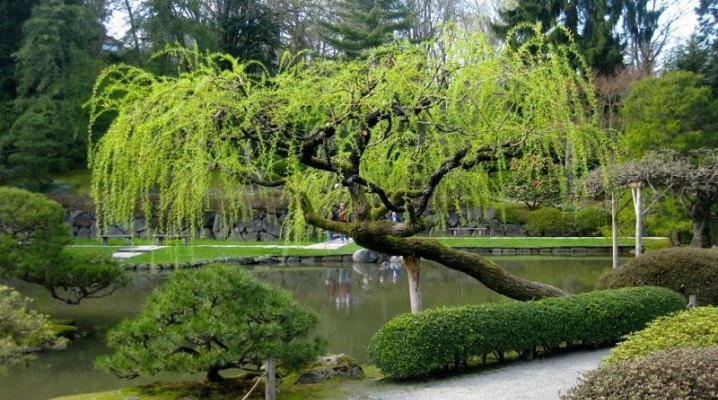
Weeping willow is an unpretentious tree that grows in the wild mainly along the shores of lakes and rivers. Planted on a personal plot, it will certainly become its most striking decoration. What types of weeping willows do modern gardeners acquire for growing? What are the nuances of planting this graceful tree in the country? How to grow it and care for it?

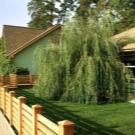
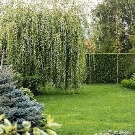

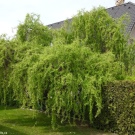
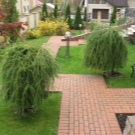
general description
Willow is an extensive genus of representatives of the Willow family, which includes both tall and dwarf woody plants with a crown of various shapes. Willows with a weeping crown are most popular with gardeners due to their amazing decorativeness, endurance, and undemanding care.
It is customary to refer to weeping willows in which the main branches of the crown are directed downward. In some species, branches can move away from the trunk for a short distance, bend in an arc and rush to the surface of the earth. In other willow species, branches can branch off from the trunk at right angles and fall down, forming an umbrella-shaped crown. In the third species, the branches only slightly move away from the trunk and fall strictly vertically, forming a crown of a narrow pyramidal-weeping shape.
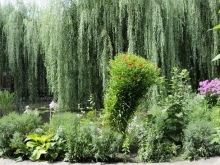
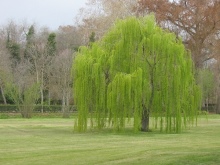
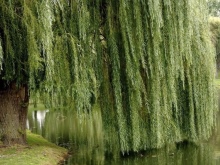
To designate the varieties of weeping crowns, experts use the following scientific terms (in Latin):
- inversa - drooping, hanging;
- pendula - weeping
- reflexa - sharply directed downward.
The height of adult willows can reach 10-15 meters or more. There are also undersized decorative varieties, whose height does not exceed 1-2 meters. Willow can be classified as a long-lived plant. On average, representatives of this genus live for about 100 years.
It is noteworthy that botanists know trees whose age has long passed the century. Thus, one of the attractions of the Moscow State University botanical garden is the willow, which is more than 300 years old.
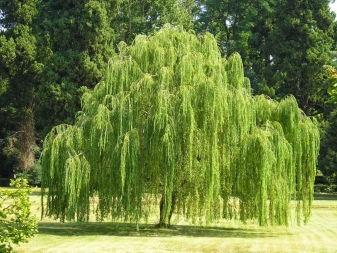

Weeping willows have a strong and well-branched root system. This root structure allows trees to receive moisture from aquifers deep underground during dry seasons. Weeping willows, depending on the species, can have grassy green, silvery green, or silvery white foliage. In most ornamental varieties, the leaves are elongated, pointed, elliptical or lanceolate, with solid or jagged edges. In some willow species, the outer surface of the leaves is covered with a barely noticeable downy.
Willow is a strong branching tree with numerous slender trunks, densely covered with thin and flexible branches with dull red or greenish gray foliage. Most representatives of the Willow family enter the flowering phase in early spring or early summer. Flowers - small, inconspicuous, collected in fluffy inflorescences (earrings) of golden-gray color. After flowering, fruits form on the plants - bivalve boxes filled with small white seeds.
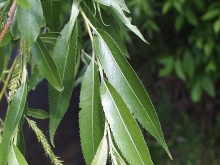
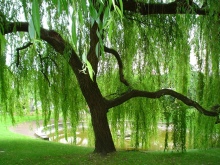
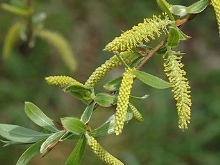
One of the features of all representatives of the Willow family is the tendency to grow rapidly in the first years of life. Under favorable environmental conditions, young willow grows very quickly, increasing the aerial part both in height and in diameter. Gardeners who grow willows in their backyard control their growth rate with formative pruning that the trees tolerate well.
In landscape design, weeping willows are widespread due to their unpretentiousness, cold and drought resistance, as well as their attractive appearance. To date, breeders have managed to obtain a number of interesting varieties and decorative forms of weeping willows, adapted to harsh climatic conditions.
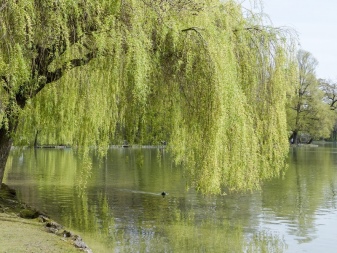
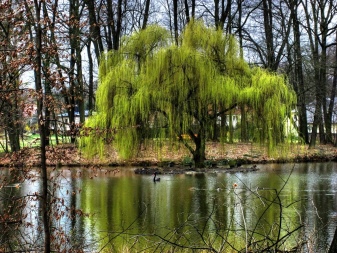
Types and varieties
Modern hybrids and varieties of willows with weeping crowns were obtained by breeders mainly from wild species. It should be noted that the assortment of decorative willows includes not only high and medium-sized forms and varieties, but also low-growing, and even dwarf ones.
Babylonian
The Babylonian willow is a wild species, the home of which is China. The species is represented by vigorous trees reaching a height of 10-12 meters. The crown of Babylonian willows is translucent, airy, lush, consisting of many thin and flexible drooping branches covered with reddish-brown or gray-green bark. The leaves are long, pointed, lanceolate, deep green on the outside and silvery green on the inside. Willows of this species take root well on all types of soils.
"Tortuoza" is a highly decorative frost-resistant variety of Babylonian willow. It is a compact tree with a lush weeping crown. The height of an adult tree does not exceed 6 meters. Shoots are long, reddish brown or olive green, covered with narrow and long leaves. Flowering time - March-April.
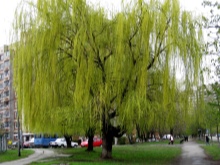
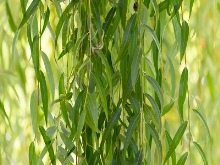

Dewy
Weeping willow dewy (another name is Siberian shelyuga) is a type of tall and powerful trees common in China and the Asian part of Russia. The view is represented by tall (up to 15 meters) and powerful trees with a lush weeping crown. Branches - drooping, rosaceous, thin, covered with dark brown or reddish-yellow bark. The leaves are lanceolate, narrow, pointed, rich green, reaching 10-12 centimeters in length.
Representatives of this species are characterized by very rapid growth (the growth of the aboveground part in one summer can be about 2 meters).
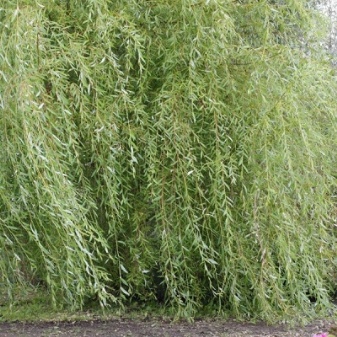

White
White willow is a typical species common in Europe and Asia Minor. It is represented by tall trees (up to 30 meters) with a tent-shaped or weeping crown. Branches are thin, sinuous, covered with reddish-brown bark. Leaves are elongated, pointed, glossy, bright green. White willows are characterized by frost resistance, undemanding soil composition. Trees tolerate pruning well, they easily take root in an urban environment.
Tristis is a spectacular white willow variety that is widely used in landscape design. It is a vigorous tree (up to 15 meters) with a spreading weeping crown. The bark is brownish-yellow, acquiring a brown color by autumn. Leaves are elongated, lanceolate, pointed. By autumn, the yellow shoots of the tree acquire a spectacular orange-burgundy hue.
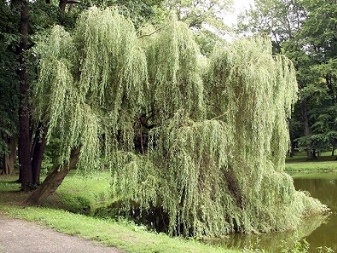
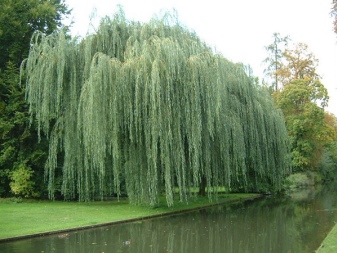
Yellow
Weeping yellow willow is a type of short trees or large shrubs, common in European countries. The plants look very unusual thanks to the long shoots of golden yellow color.
Yellow willows are not demanding on the composition of the soil, light-requiring, frost-hardy, painfully tolerate drafts and wind.
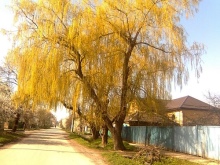
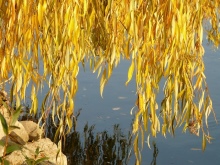
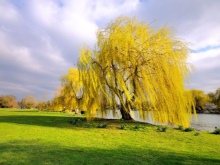
Yellow-mouthed
The weeping yellow-brown willow is a hybrid of two types of willows - Babylonian and white. It is a tall tree (up to 20 meters) with a long, even trunk and a lush drooping crown. The plant is especially attractive due to its spectacular long shoots of a deep yellow color. The hybrid is considered a very unpretentious plant that easily takes root in harsh climatic conditions.

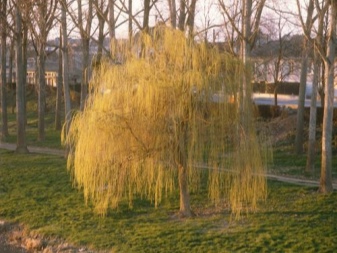
Whole-leaved
Whole-leaved willow is a type of low-growing and dwarf shrubs common in Primorye and Japan. The maximum size of adult plants is about 3 meters in height and 1-1.5 meters in crown diameter.Branches - flexible, spreading, densely covered with narrow pointed leaves of dark green color. By trimming the crown of the plant, you can give both a weeping and a spherical shape.
- "Hakuro Nishiki" - a variety of whole-leaved willow adapted to harsh climatic conditions. It is a spreading bush or a low tree with graceful flowing branches. The young leaves of this dwarf willow cover the original bright pink spots. The variety tolerates a haircut well, hibernates without problems in the conditions of the Moscow region.
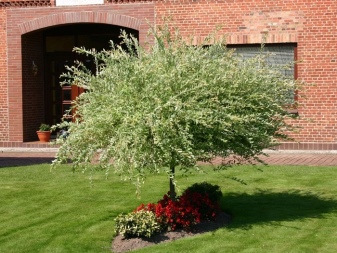
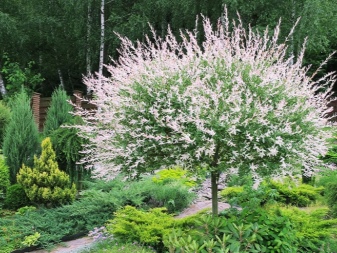
- "Ideal" - hybrid willow, bred by the famous domestic breeder V. Shaburov. It is a strong and very slender tree up to 10-12 meters high. Crohn - lush, weeping, wide-oval shape. The color of the shoots is olive green or brownish red. Does not bloom. Seedlings of this variety are planted immediately to a permanent place.
Transplanting plants is strongly discouraged.
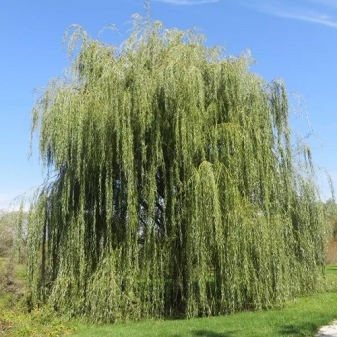
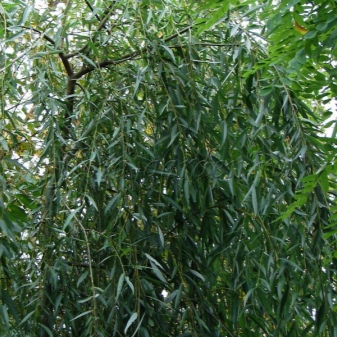
Landing
Before planting a willow, you need to choose the right place for it on the site. These plants prefer sunny corners of the garden, protected from drafts and wind. Young plants can also be planted in light partial shade. Areas with well-moistened sandy loam or loamy soils are best suited for weeping willows. It should be remembered that in the wild, willows prefer to grow in humid places - in floodplains of rivers, on the shores of ponds and lakes. The size of the planting pit should slightly exceed the size of the root ball of the seedling. Experienced gardeners recommend equipping pits with a depth of at least 60-70 centimeters.
Before planting a seedling, the pit must be filled by a third with a nutrient mixture consisting of garden soil, humus and compost. The mixture is poured to the bottom, after which a mound is formed from it. Next, the seedling is removed from the container, its roots are straightened and placed vertically in the pit. After that, the pit is filled with garden soil to the brim. The surface of the earth in the near-trunk circle is tamped with a spatula or palms. After planting, the young plant is watered. The recommended amount of water is 2 buckets.
After watering, the soil surface is sprinkled with mulch - wood chips, expanded clay or peat.
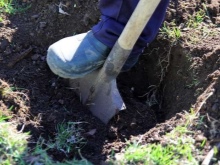
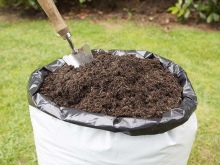
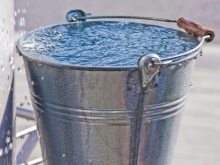
Care features
Experienced gardeners say that it is not difficult to care for weeping willows. These unpretentious plants easily tolerate drought, frost, quickly adapt to new conditions after transplanting. In the first season after planting, young plants require a large amount of water - from 10 to 25 liters (depending on the type and size of the seedling) per week. In a cold summer, willows are recommended to be watered abundantly once every 10-14 days.
If the willow crown has dried up, but the plant is regularly watered, this may indicate a lack of moisture in the air. So that the tree does not lose its decorative effect, in hot weather (in the evening or in the morning), it is necessary to spray its aerial part from a spray bottle. It is not allowed to spray willow during the day when the sun is at its maximum.
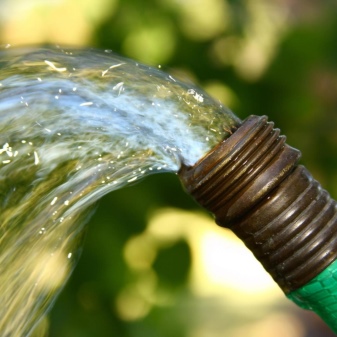
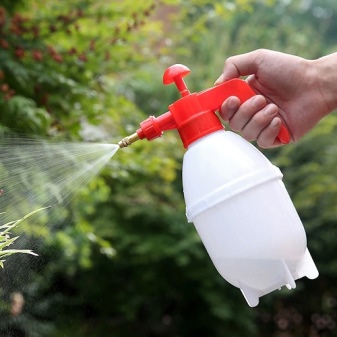
Regular pruning of the tree will help to contain the rapid growth of the shoots and form a compact crown shape. Gardeners recommend that the first pruning of willow be done after the height of the tree is about 1 meter. Prune the plants after flowering, shortening the shoots by about 20 centimeters. In the course of pruning, make sure that several buds remain on the shortened shoots, directed to the side and up. In the future, long cascading shoots will develop from these buds, which will form a neat weeping crown.
Weeping willows practically do not need feeding - in this respect, they can be considered "self-sufficient" plants. However, many gardeners still feed their weeping beauties with organic fertilizers in the spring. Such top dressing allows trees to quickly build up root and green mass after wintering.To feed the plants, humus or rotted manure is usually used. It is allowed to use ready-made complex fertilizers containing nitrogen. Weeping willows do not require shelter for the winter. However, in regions with severe frosty winters, it is recommended to cover young trees with agrofibre and spruce branches to protect them from freezing.
Some gardeners make winter shelters from several layers of burlap for their young willows.
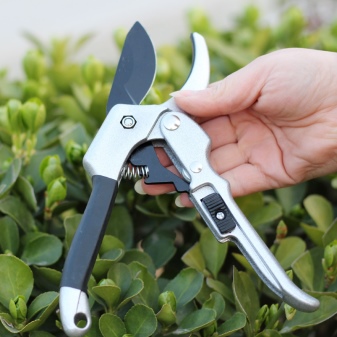
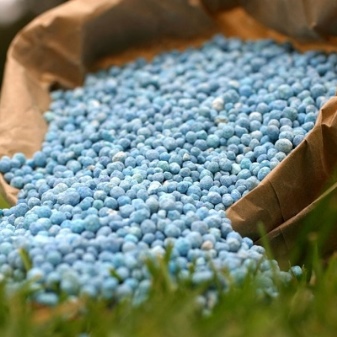
How does it multiply?
In the wild, weeping willows reproduce mainly by seeds. After cracking the pods, the willow seeds, covered with fluff, are easily spread with the wind over long distances. Gardeners, on the other hand, prefer to propagate weeping willows by cuttings - a method that allows you to quickly get a new generation of woody plants of the desired type and variety. Cuttings are harvested in spring or autumn.
The basis of the planting material is healthy young branches at the age of 2-3 years. Cuttings 25-30 centimeters long are cut from the middle part of the branches, which are planted in a greenhouse or home mini-greenhouse, placing them in the ground at a slight angle (diagonally). When planting in a home greenhouse, the cuttings are covered with a jar of a suitable size or with a frame film cover.
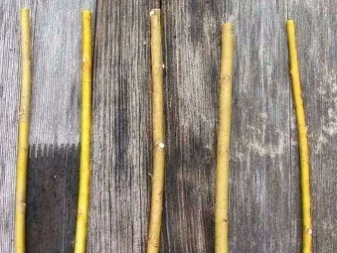
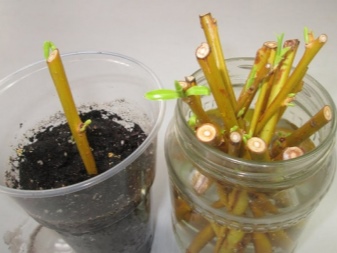
Throughout the rooting process, cuttings are watered regularly to keep the soil moist. Do not allow the soil to dry out in the greenhouse or greenhouse. The fact that the cuttings of the weeping willow were able to take root safely will be evidenced by the gradual growth of the shoot in height and the formation of the first leaves on it. Experienced gardeners claim that using cuttings, almost any type of weeping willow can be cultivated.
After the rooted stalk gets stronger and turns into a full-fledged plant, it can be planted in open ground in a permanent place. In the spring, the rooted cutting is planted in open ground only after the threat of frost return has passed. It is not recommended to plant rooted cuttings in autumn due to their inability to rapidly changing environmental conditions (a sharp drop in air temperature).
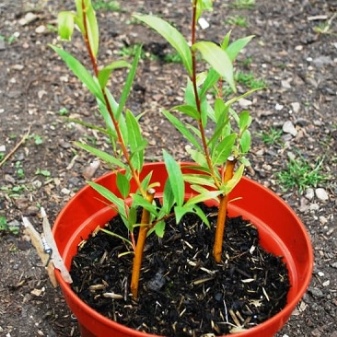

Diseases and pests
One of the most common diseases of weeping willows is scab. When a scab is affected, a tree or bush stops growing, and black-green spots of arbitrary shape appear on their leaves. Dark ulcers begin to form on the branches of the plant, and the shoots turn black. In the future (in the absence of timely treatment), the affected willow sheds blackened foliage. Along with this, the immunity of the tree itself is significantly reduced, which begins to dry out and wither quickly.
The causative agent of willow scab is a pathogenic fungus that actively reproduces by spores. The main methods of combating the disease include:
- destruction of the affected parts of the plant;
- total treatment of a bush or tree with fungicidal preparations of a wide spectrum of action ("Fundazol", "Ciproconazole", "Alirin-B");
- processing of neighboring bushes and soil in the near-trunk circle with fungicidal preparations.
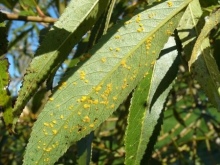
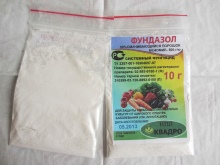
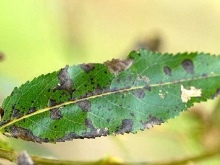
In order to prevent the disease, weeping willows are sprayed with fungicides at least 3-5 times during the growing season. The first treatment of plants with fungicides is carried out in early spring, before the appearance of the first leaves. It is also important to note that the scab pathogen prefers to parasitize in fallen dry leaves. For this reason, before wintering, dry leaves that have flown from willows are recommended to be collected with a rake and burned.
One of the most dangerous pests of weeping willows is a representative of the Weevils family, which is called "fertile crusader". The adult is a very small black and white beetle, the body length of which does not exceed 2.5 mm. The larvae of this pest, which can be found in the galls formed on willow leaves, are especially dangerous.The main methods of dealing with this pest are the destruction of the affected parts of the plant and its careful treatment with insecticidal preparations. In particular, insecticides such as:
- Aktara;
- "Spark-Double Effect";
- Fitoverm;
- Fufanon-nova.
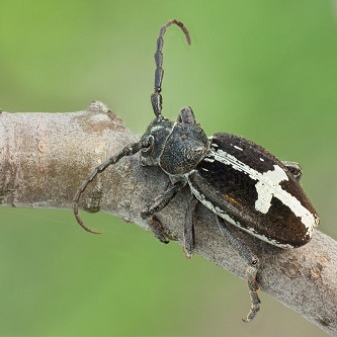
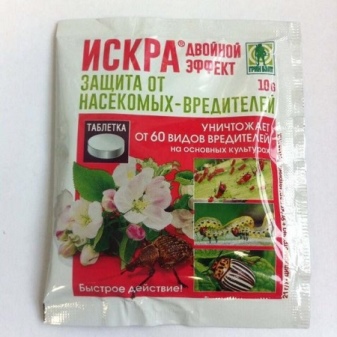
Often, weeping willows are attacked by a rather dangerous winged insect - the crooked leafworm. This pest is a large gray-brown butterfly, whose caterpillars and larvae feed on leaves, buds and young shoots of plants. As a result of the activity of pests, the foliage of the willow, affected by the leaf roll, begins to curl and die off. For the treatment of the affected bushes, it is recommended to use insecticidal preparations - "Aktara", "Fitoverm", "Karbofos", "Lepidotsid".
In order to prevent the defeat of weeping willows by insects and pathogens of various diseases, it is necessary to provide the plants with high-quality and regular care.
Failure to follow the recommendations for caring for ornamental shrubs can lead to a weakening of their immunity and, as a consequence, a decrease in their resistance to pests and pathogens.

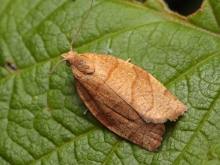
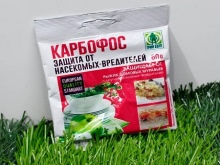
Application at the summer cottage
Both tall and dwarf weeping willows are commonly used by landscape designers as solo plants. They are often grown against the backdrop of emerald grassy lawns and decorative beds of stones and ground cover plants. The weeping willow looks as effective as possible, according to landscape designers, against the background of artificial reservoirs - small decorative streams or ponds. A compact garden fountain decorated with natural stone can be a good alternative to a decorative pond.
Weeping willows also look good in group compositions with low decorative annuals and perennials. So, in the vicinity of a tree, it is recommended to grow hosts (especially their bright variegated forms), nasturtiums, undersized ferns, lilies of the valley, redwoods, crocuses.
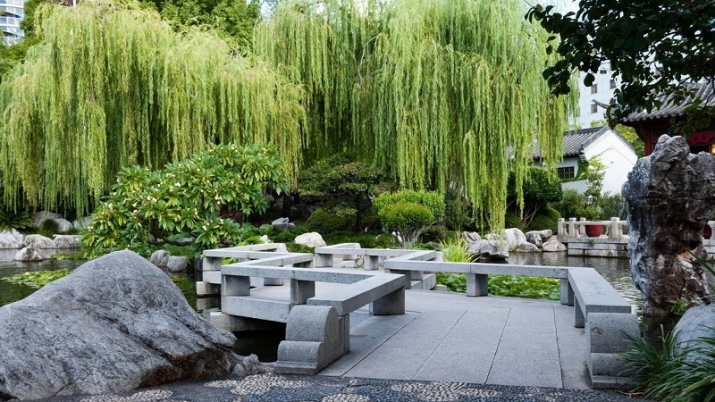
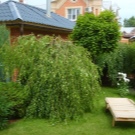
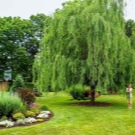
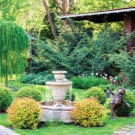
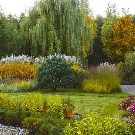
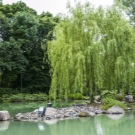
In addition to them, meadow grasses will look organic with weeping willow - perennial ryegrass, fescue, bluegrass, thyme, willow tea, undersized daisies, bells, clover.
To beautifully decorate the space empty under the weeping willow, landscape designers recommend using colored expanded clay. This environmentally friendly free-flowing material can act not only as a catchy decoration of the tree trunk circle under the plant, but also as an excellent mulch that prevents rapid evaporation of moisture from the soil in hot weather.
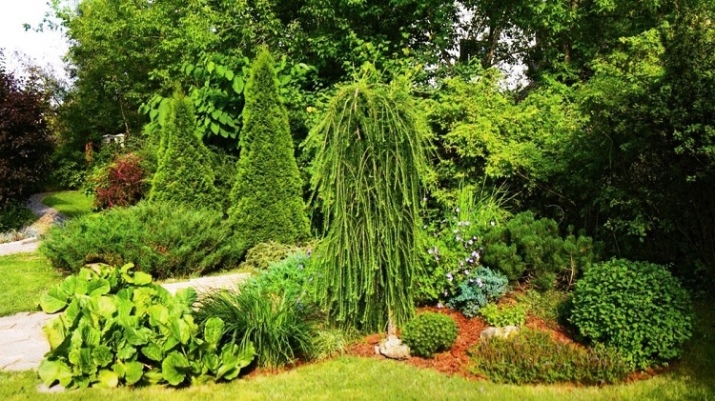
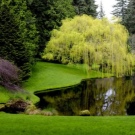
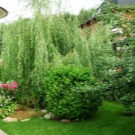

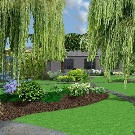




































































The comment was sent successfully.